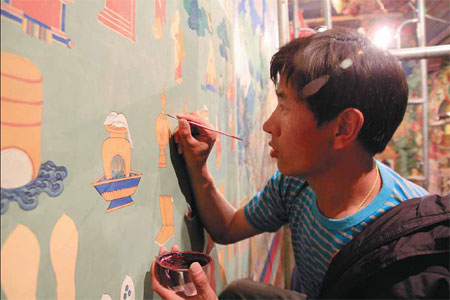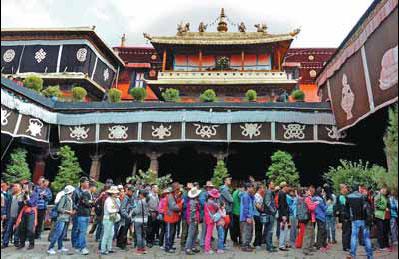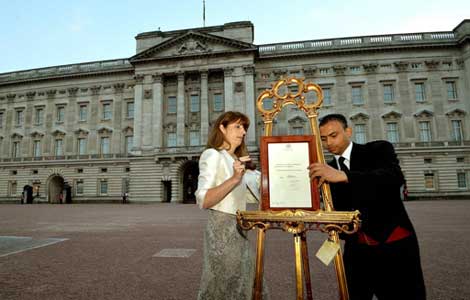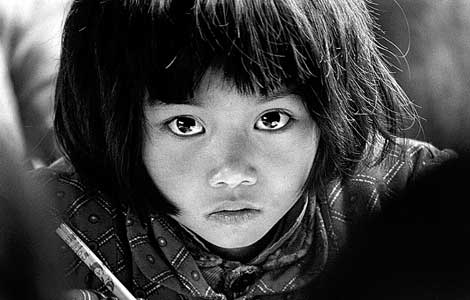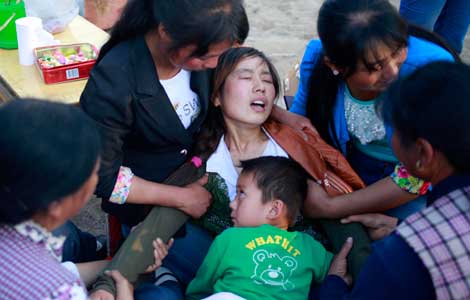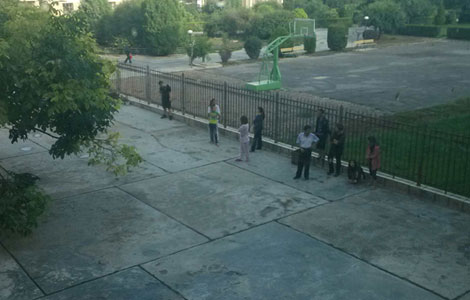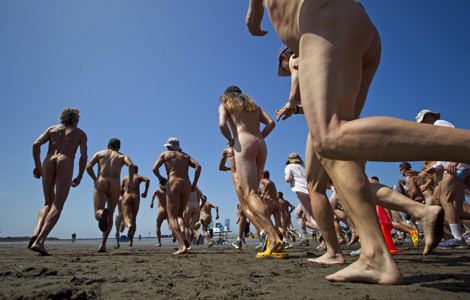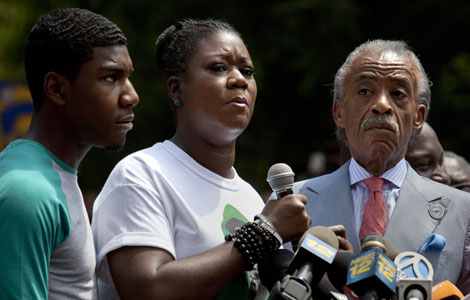Giving ancient Lhasa a facelift
Updated: 2013-07-23 07:30
By Wang Huazhong and Da Qiong (China Daily)
|
||||||||
|
Puntsog, from Lhundrub county, and his teacher spent 18 months restoring a 12-square-meter fresco in Lhasa's Ramoche Temple. Wang Huazhong / China Daily |
|
Tourists wait to enter Jokhang Temple in downtown Lhasa. The high season for visitors started in late June, and the city receives an average of 4,000 tourists every day. Wang Song / Xinhua |

Six months' work and $244 million have restored an ancient area of the city, as Wang Huazhong and Da Qiong report.
Small shops along Barkhor Street in Lhasa had not yet opened at 6 am, but new lamps, adorned with an auspicious Tibetan knot, Buddhist symbols and scripture texts, cast a warm glow over those who had risen early to pray.
The devotees moved around Jokhang Temple in a clockwise direction, chanting sutras that echoed each other.
The air smelled of night rain, local flowers, and the barley and pine branches that burned in the street.
Flower vendor Drolkar, from Doilungdeche county, said: "I grew the galsang metog flowers myself. You can offer them at the temple or take some home. I'm very grateful for the recent clearance of the drainage area. Otherwise, I'd have no place to sell my flowers. Before, the sewage flooded the street when it rained."
The old urban area of Lhasa, which sprawls from the center of Barkhor Street, has a rich traditional and religious flavor. It is home to 27 temples, including Jokhang Temple, which is a World Heritage Site, and 56 vintage courtyards.
The government has renovated 1,300-year-old Barkhor Street many times before; in 2002 alone, it spent 170 million yuan ($27.6 million) on improvements.
But the infrastructure still lagged far behind the needs of the burgeoning businesses, booming religious activities and people's lives. More than 6 million tourists flock to the Tibet autonomous region annually and the population of the 1.33-square-km old town has risen to 80,000.
Before the latest renovations, cables intertwined like cobwebs hung over Barkhor's 35 alleys. Power and water supplies were inadequate and inaccessible in many areas.
The city government started the latest renovation drive, the third in recent history, in late December, investing 1.5 billion yuan in the six-month project.
Its primary aims were: to protect the historic heritage, improve the lives of the locals, and conserve the culture, according to the feasibility study for the effort.
"The project's main priority was to improve the civil infrastructure and eliminate safety hazards, such as fire risks," the report said.
Infrastructure update
Nyima Tsering, 79, was born and raised on Barkhor Street and remembers clearly how the place looked when he was a child.
He said the wind blew dust into the stalls along the narrow earth road during the hot summer. At the time, Nyima Tsering's house was the property of Tashilhunpo Monastery and beggars gathered around it.
Previous renovations freed his six-member family from drinking water from a well, using a non-flush toilet and having to light candles for illumination, yet he said their lives had remained "not so convenient" until recently.
The courtyard in which he lives is home to several families, about 26 people in all, including seniors aged 80 and older. They all shared one water tap on the ground floor before the latest renovation was completed at the end of June.
Before that, water couldn't even be pumped up to the second floor.
Because the pipes were just 20 cms in diameter, the drainage system failed to discharge sewage from many households. Foul water gushed out onto the street on rainy days, Nyima Tsering said.
In all, 199 courtyards are scattered along 35 alleys in the Barkhor Street area.
Tashi Dorje, a deputy in Lhasa's city congress, said that in the old house-intensive district, sewage and the fires used for cooking and heating threatened the safety of the crowded courtyards.
The renovation project has helped change the situation, the project leaders said.
Now all the overhanging cables have been buried underground in 31 km of piping tubes and tunnels.
More than 17,000 households now have their own electricity meters, which means they no longer share the bill with other courtyard residents.
To date, 1.2 km of new water pipes have been laid and 7 km of existing pipelines have been renovated. About 650 truckloads of mud were cleared from the drainage intakes.
Forty-six fire hydrants were installed and 2,200 km of decayed or illegally connected cables have been removed.
Yet what satisfies Nyima Tsering most is that the road he travels every day to pray has been widened and flattened.
The surface of the new roadway on Barkhor Street uses anti-slip bluestones that absorb, rather than reflect, strong sunlight and a lane in the middle of the road has been paved with smooth stones for the worshippers who prostrate themselves along its length.
More than 1,000 new street and wall lamps, all bearing Tibetan designs, have also been installed.
The old lamp bulbs were shaped like flowers, but the new designs look like prayer wheels and incorporate many Tibetan elements, such as the greeting tashi delek, which means "good fortune".
"The street was very busy and noisy. But now, I don't have to turn up the TV volume much because of the new windows," said Tsering lhamo.
The windows of her living room along Barkhor Street are double-glazed, insulating the house from noise and cold. A yellow wooden lattice painted with auspicious Tibetan signs hangs outside the window.
"I'm pleased to see that the old district has changed for good," Nyima Tsering said. "My children will live a better life and the old district will become more beautiful."
When the project was completed, the government of Chengguan district, where the renovation took place, conducted a survey to solicit public feedback on the quality of the work.
All the respondents from the 12 local communities said they were "satisfied" or "very satisfied" with the results.
The old district is the original soul of Lhasa and a mirror that showcases the city's charm and history.
Conserving heritage
Wu Yingjie, deputy Party chief of the Tibet autonomous region, asked local authorities and builders to "take people's living conditions as the top priority, and to make the protection of the culture and heritage one of the most important tasks" during the project.
The goal was "to help the old district of Lhasa spark vitality and dynamism against the backdrop of a new era", he said.
According to the project administrators, the design department conducted surveys about the old buildings and asked Tibetan architects for their guidance so the area could be "rebuilt as it originally was".
At a news conference, officials said, "The renovation rigorously abides by Tibetan culture in the choice of construction materials, range of colors and style."
"We tried to save the original facades of the buildings as much as possible," said Tsedar, deputy head of the restoration project. "We didn't make major changes if minor alternations could meet the demand. We avoided using replacement elements and moving objects around."
Structural engineer Liu Yu said before-and-after blueprints have been kept for each of the 172 buildings with unique and spectacular elements.
The Lhasa government has also invested 300 million yuan on nine major cultural protection projects, including an upgrade of the firefighting system in Jokhang Temple and the restoration of frescos and the statues of the Four Heavenly Kings in Ramoche Temple.
Family members taught Asong, from Gonggar county in Lhokha, to make clay figurines and he has practiced the art for 22 years. He joined the project and led apprentices on a six-month project to rebuild the Four Heavenly Kings.
"Only two other temples house statues of equivalent size to the Shakyamuni in Lhasa. One is Jokhang and the other is Ramoche Temple. I'm very honored to have the opportunity to restore statues at temples with centuries of history."
He said the Four Heavenly Kings are the biggest statues in Lhasa: "Our restoration will make the statues last for a long time regardless of the cost," adding that the Four Heavenly Kings have a human look and so allow the artists license to use their imaginations.
"Despite the requirement that we should follow the body scale of the deities strictly in accordance with descriptions, we can illustrate their characters in different ways," he said. "We give the same deity different looks. That's the amazing thing about clay."
Erik Ziarczyk, a Belgian journalist who toured the old district, said he liked it very much. "I want to walk around more to see the little stores and I also want to have dinner there in one of those little restaurants," he said. "It's all very interesting."
Palden Nyima contributed to this story.
Contact the writers at wanghuazhong@chinadaily.com.cn and daqiong@chinadaily.com.cn
(China Daily USA 07/23/2013 page7)
Most Viewed
Editor's Picks
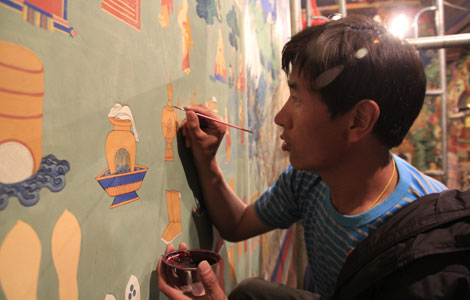
|

|

|
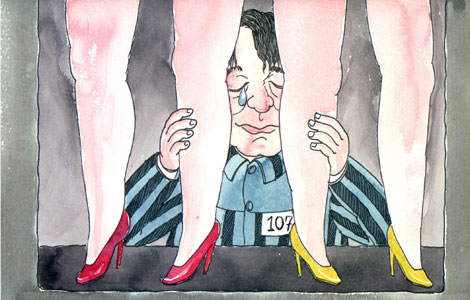
|

|

|
Today's Top News
Germany to probe spy services' ties with US
Snowden hopes to leave airport by Wednesday
Quake in NW China kills 89, injures 700
US blacks, whites split on Zimmerman verdict: poll
Kissinger and Jiang see bright future for relations
China sees no major forex withdrawal: regulator
Business holds up for Minmetals arm
Beijing knife attack leaves one dead
US Weekly

|

|
